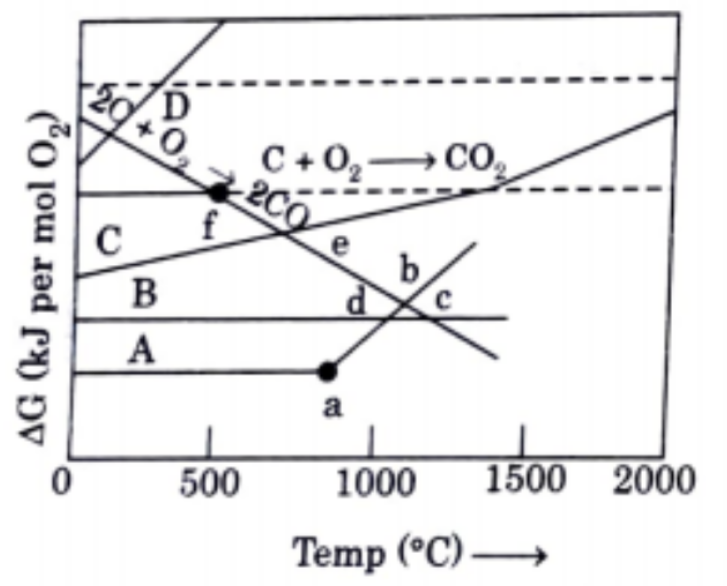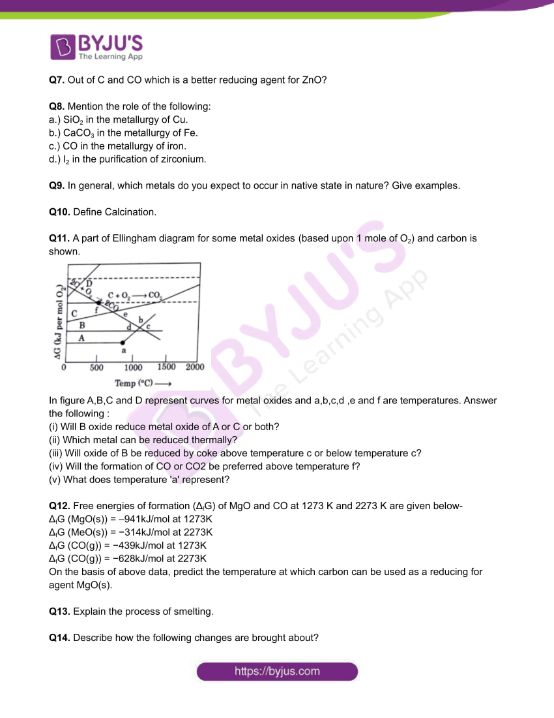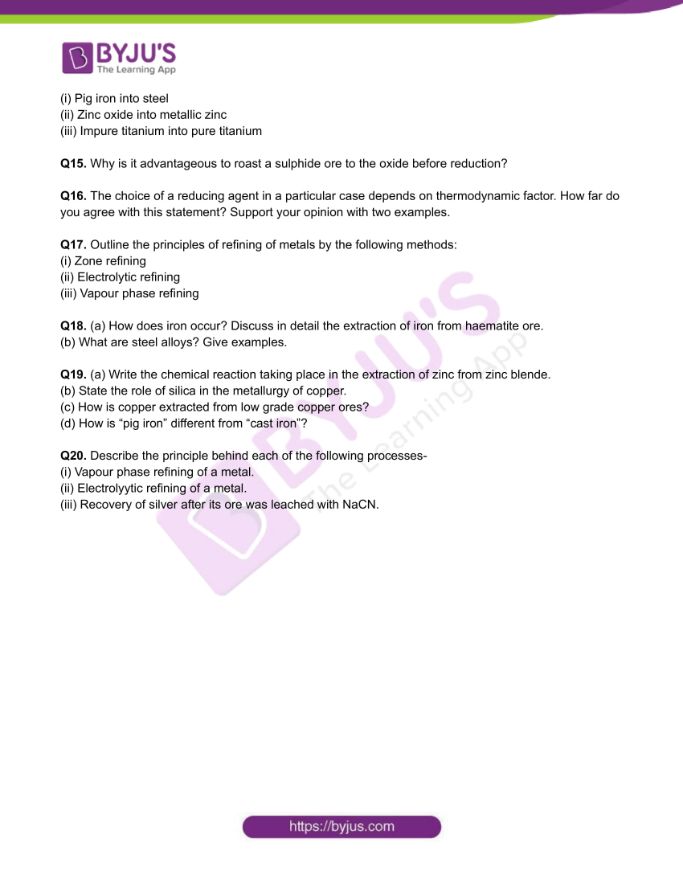Elements occur in nature either in the combined state or in a free state. Those occurring in free state or native are few. Metals occurring in free state are copper, silver, gold, platinum and other platinum group metals.
Metals are essential for different purposes. Therefore extracting them from the mineral resource in a commercially feasible way is important. The minerals in which the metal is present and extracted are called ores. Usually, the ores contain impurities which can be removed to a certain limit in the concentration steps. After this step, the ore is chemically treated to obtain metals. With the help of reducing agents such as CO, carbon, etc. the metal compound is reduced to metal.
Step 1-The metal oxide reacts with a reducing agent;
Step 2 (a)-The oxide reduces to metal
Step 2 (b)-Oxidation of reducing agent
Download Class 12 Chemistry Worksheet on Chapter 6 General Principles and Processes of Isolation of Elements PDF – Set 2
CBSE Class 12 Chemistry Chapter 6 General Principles and Processes of Isolation of Elements Worksheet – Set 2
Q1. Nitriding is the process of surface hardening of steel by treating it in atmosphere of-
a.) NH3
b.) O3
c.) N2
d.) H2S
Q2. Purification of aluminium, by electrolytic refining is known as-
a.) Hoope’s process
b.) Baeyer’s process
c.) Hall’s process
d.) Serpeck’s process
Q3. Extraction of gold and silver involves leaching with CN– ion. Silver is later recovered by-
a.) distillation
b.) zone refining
c.) displacement with Zn
d.) liquation
Q4. 2CuFeS2 + O2 → Cu2S + 2FeS +SO2
Which process of metallurgy of copper is represented by above equation?
a.) Concentration
b.) Roasting
c.) Reduction
d.) Purification
Q5. Identify the correct statement from the following:
a.) Wrought iron is impure with 4% carbon.
b.) Blister copper has blistered appearance due to evolution of CO2.
c.) Vapour phase refining is carried out for nickel by Van Arkel method.
d.) Pig iron can be moulded into a variety of shapes.
Q6. What is the role of flux in metallurgical processes?
Q7. Out of C and CO which is a better reducing agent for ZnO?
Q8. Mention the role of the following:
a.) SiO2 in the metallurgy of Cu.
b.) CaCO3 in the metallurgy of Fe.
c.) CO in the metallurgy of iron.
d.) I2 in the purification of zirconium.
Q9. In general, which metals do you expect to occur in native state in nature? Give examples.
Q10. Define Calcination.
Q11. A part of Ellingham diagram for some metal oxides (based upon 1 mole of O2) and carbon is shown.

In figure A,B,C and D represent curves for metal oxides and a,b,c,d ,e and f are temperatures. Answer the following :
(i) Will B oxide reduce metal oxide of A or C or both?
(ii) Which metal can be reduced thermally?
(iii) Will oxide of B be reduced by coke above temperature c or below temperature c?
(iv) Will the formation of CO or CO2 be preferred above temperature f?
(v) What does temperature ‘a’ represent?
Q12. Free energies of formation (ΔfG) of MgO and CO at 1273 K and 2273 K are given below-
ΔfG (MgO(s)) = –941kJ/mol at 1273K
ΔfG (MeO(s)) = −314kJ/mol at 2273K
ΔfG (CO(g)) = −439kJ/mol at 1273K
ΔfG (CO(g)) = −628kJ/mol at 2273K
On the basis of above data, predict the temperature at which carbon can be used as a reducing for agent MgO(s).
Q13. Explain the process of smelting.
Q14. Describe how the following changes are brought about?
(i) Pig iron into steel
(ii) Zinc oxide into metallic zinc
(iii) Impure titanium into pure titanium
Q15. Why is it advantageous to roast a sulphide ore to the oxide before reduction?
Q16. The choice of a reducing agent in a particular case depends on thermodynamic factor. How far do you agree with this statement? Support your opinion with two examples.
Q17. Outline the principles of refining of metals by the following methods:
(i) Zone refining
(ii) Electrolytic refining
(iii) Vapour phase refining
Q18. (a) How does iron occur? Discuss in detail the extraction of iron from haematite ore.
(b) What are steel alloys? Give examples.
Q19. (a) Write the chemical reaction taking place in the extraction of zinc from zinc blende.
(b) State the role of silica in the metallurgy of copper.
(c) How is copper extracted from low grade copper ores?
(d) How is “pig iron” different from “cast iron”?
Q20. Describe the principle behind each of the following processes-
(i) Vapour phase refining of a metal.
(ii) Electrolytic refining of a metal.
(iii) Recovery of silver after its ore was leached with NaCN.
Download PDF to access answers of Chemistry Worksheet for Class 12 Chemistry Chapter 6 General Principles and Processes of Isolation of Elements set – 2.
Download PDF
Read Also:
- General Principles and Processes of Isolation of Elements Class 12 Notes Chapter 6
- General principles and Processes of Isolation of Elements MCQs
- NCERT Solutions for Class 12 Chemistry Chapter 6 General Principles and Processes of Isolation of Elements
- Important Questions for Class 12 Chemistry Chapter 6 – General Principles and Processes of Isolation of Elements



Comments